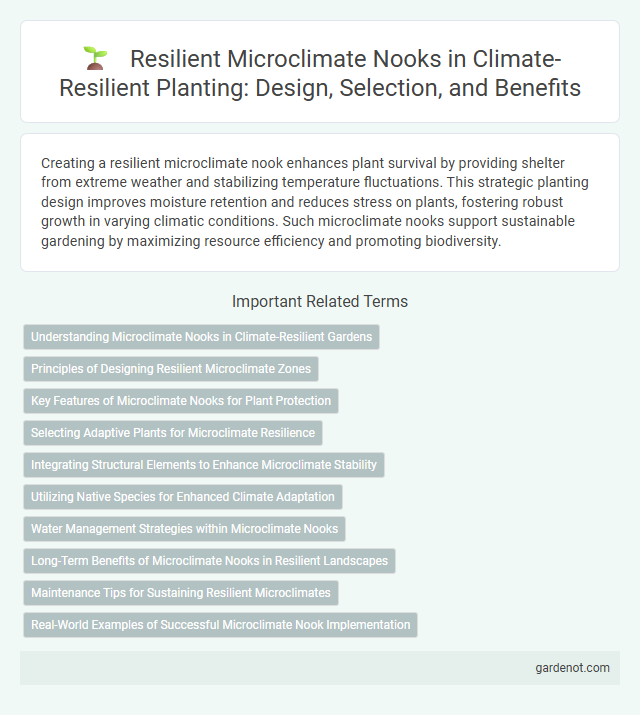Creating a resilient microclimate nook enhances plant survival by providing shelter from extreme weather and stabilizing temperature fluctuations. This strategic planting design improves moisture retention and reduces stress on plants, fostering robust growth in varying climatic conditions. Such microclimate nooks support sustainable gardening by maximizing resource efficiency and promoting biodiversity.
Understanding Microclimate Nooks in Climate-Resilient Gardens
Microclimate nooks in climate-resilient gardens create localized environments that moderate temperature, humidity, and wind exposure, enabling diverse plant species to thrive despite broader climatic challenges. These sheltered spots optimize moisture retention and reduce heat stress, contributing to enhanced biodiversity and prolonged plant health during extreme weather events. Strategic design of microclimate nooks using natural features like berms, windbreaks, and shade structures supports microhabitats essential for developing adaptive, resilient plant communities.
Principles of Designing Resilient Microclimate Zones
Designing resilient microclimate zones involves strategically positioning vegetation, water features, and structures to optimize shade, wind protection, and humidity control, thereby enhancing plant survival under climate stress. Key principles include selecting native and drought-tolerant species, creating layered vegetation to buffer temperature extremes, and maximizing soil moisture retention through mulching and ground cover. Incorporating these elements fosters microclimates that mitigate heat, reduce evapotranspiration, and improve overall ecosystem resilience against climate variability.
Key Features of Microclimate Nooks for Plant Protection
Microclimate nooks create sheltered environments that buffer plants against extreme temperatures, wind, and moisture fluctuations, enhancing survival and growth. Key features include strategic orientation for optimal sunlight exposure, use of natural windbreaks like shrubs or stones, and soil amendments to retain moisture and regulate temperature. These design elements collectively foster microhabitats that increase plant resilience to climate stressors and support biodiversity.
Selecting Adaptive Plants for Microclimate Resilience
Selecting adaptive plants for a resilient microclimate nook involves choosing species with proven tolerance to local climate extremes, such as drought-resistant succulents and shade-loving ferns. Incorporating native plants enhances soil stability and reduces water use, supporting ecosystem balance and long-term resilience. Strategic placement of these adaptive plants creates natural windbreaks and humidity buffers, optimizing microclimate conditions and promoting sustainable growth.
Integrating Structural Elements to Enhance Microclimate Stability
Integrating structural elements such as permeable walls, shading devices, and water features creates a resilient microclimate nook that stabilizes temperature fluctuations and reduces wind impact. These components work synergistically to maintain humidity levels and promote air circulation, enhancing plant survival under extreme weather conditions. Strategic placement of such structures supports biodiversity by providing shelter and optimizing light exposure within climate-resilient landscapes.
Utilizing Native Species for Enhanced Climate Adaptation
Utilizing native species in resilient microclimate nooks enhances climate adaptation by leveraging plants already adapted to local environmental conditions, improving survival rates and ecosystem stability. These native species contribute to soil health, water retention, and biodiversity, creating a microhabitat that buffers extreme temperatures and mitigates climate stressors. Incorporating local flora strengthens ecological networks and supports pollinators, fostering long-term resilience in urban and rural landscapes.
Water Management Strategies within Microclimate Nooks
Resilient microclimate nooks incorporate advanced water management strategies such as rainwater harvesting, drip irrigation, and soil moisture retention techniques to optimize water use efficiency. These practices reduce runoff, enhance groundwater recharge, and maintain consistent hydration for plants during drought periods. Integrating permeable surfaces and mulching further supports soil health and promotes sustainable microclimate resilience.
Long-Term Benefits of Microclimate Nooks in Resilient Landscapes
Microclimate nooks create sheltered environments that stabilize temperature and moisture levels, enhancing plant survival during extreme weather events. These localized refuges promote biodiversity and improve soil health by reducing erosion and retaining nutrients over time. Integrating microclimate nooks into resilient landscapes supports sustained ecosystem productivity and climate adaptation.
Maintenance Tips for Sustaining Resilient Microclimates
Regular watering schedules with drought-tolerant plants help maintain soil moisture and reduce heat stress in resilient microclimates. Mulching around plants minimizes evaporation, controls weeds, and improves soil quality, essential for sustained microclimate benefits. Pruning and removing invasive species encourage healthy plant growth and preserve the intended microclimate conditions over time.
Real-World Examples of Successful Microclimate Nook Implementation
Resilient microclimate nooks enhance plant survival by creating sheltered, moisture-retentive environments tailored to local climate challenges. A pioneering example is Melbourne's urban parks, where strategically planted native shrubs and canopy trees reduce wind exposure and buffer temperature extremes, significantly improving seedling establishment rates. Similarly, community gardens in Barcelona utilize microclimate nooks with recycled materials and diverse plant species to conserve water and promote biodiversity under Mediterranean heat stress.
Resilient microclimate nook Infographic

 gardenot.com
gardenot.com